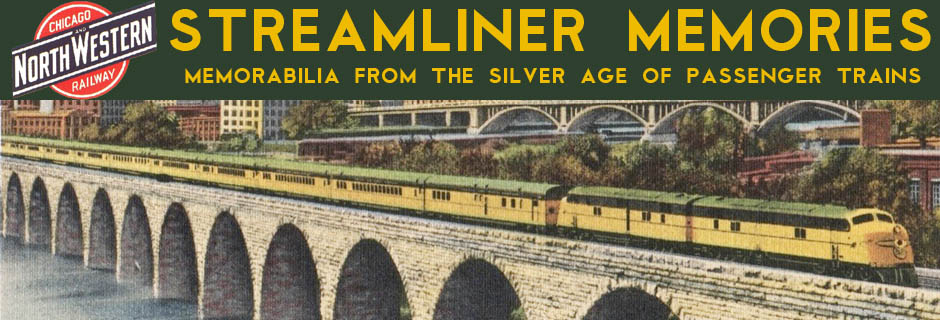Northern Pacific’s land grant called for it to build from Lake Superior to Puget Sound. However, it was nearly financially exhausted when it reached Washington territory in 1883. There, it met with the Oregon Railway & Navigation Company, which went on the south bank of the Columbia River to Portland.
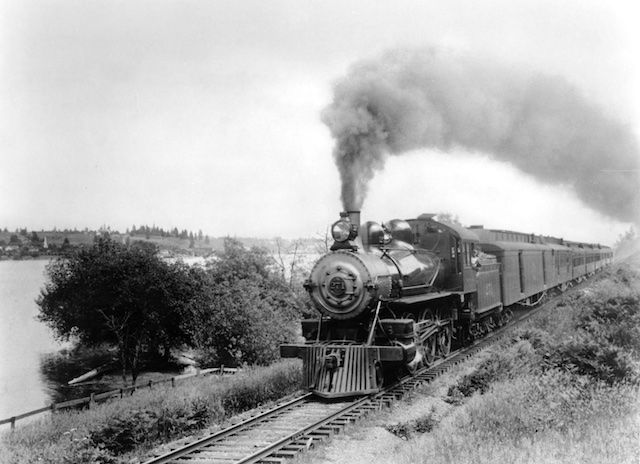
The first run of the North Coast Limited, at least according to the Texas History web site. Texas History doesn’t know who took the photo, but it was probably George Weister, the Portland photographer who took the next photo. Click image for a larger view.
At the time, both the OR&N and NP were under the financial control of Henry Villard, so NP began passenger service from the Twin Cities to Portland using the OR&N for the last 214 miles. The first passenger train over the 1,912 miles to Portland took 82 hours for an average speed of 23 mph. In the timetables this train, which made more than 180 stops between St. Paul and Portland, is known only as the “Express.”
NP soon built a line over the Cascade Mountains direct to Tacoma. Its transcontinental train split at Pasco, Washington, with part going to Tacoma (1,912 miles) and part going over the OR&N to Portland. As of 1888, the Portland section took a little more than 74 hours (25 mph) while the Tacoma section took more than 76 hours (24 mph). The timetable in the Official Guide called the Portland section trains 1 & 2 but the Tacoma section was the Pacific Express and Atlantic Express.
By 1900, when the Northern Pacific introduced the North Coast Limited, the Oregon Railway & Navigation Company had fallen under the control of rival Union Pacific. The NP therefore routed the NCL to Tacoma and then continued on to Portland by going south to Kalama, taking a ferry across the Columbia River to a town called Goble, and then to Portland. The train made only half as many stops as the previous 1 & 2, so it only took 62 hours to Tacoma (31 mph), but required 10 more hours to get to Portland, making it only slightly faster than in 1888.
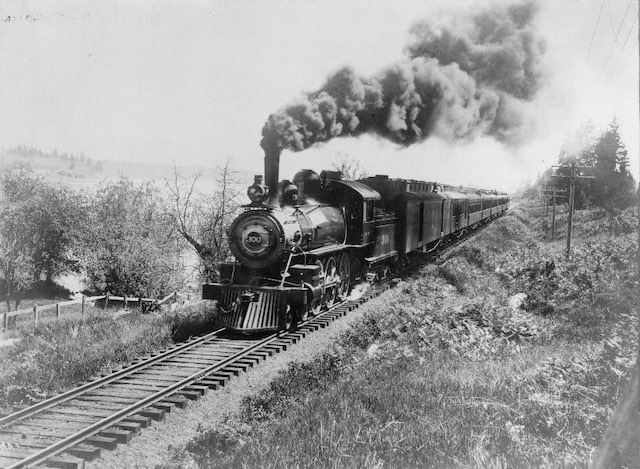
This photo of the North Coast Limited in the Library of Congress was taken by Portland photographer George Weister. Wikipedia says this was the first run of the train, but the Library of Congress doesn’t make that claim. Click image for a larger view.
While NP used 4-4-0s to pull its passenger trains in the 1880s and early 1890s, by 1900 it had 4-6-0s for the first run of the North Coast Limited. The Texas History web site has a photo that purports to show the first run of the North Coast Limited on April 29, 1900. The Library of Congress also has a photo of the train which Wikipedia also claims is the first run on April 29, 1900.
A close look reveals that both photos were taken from the exact same spot on the Columbia River as the train heads to the ferry landing where it will cross the river. The locomotives in the two photos are different: the first is #271, an 1897 Schenectady model with 69″ drivers and 25,623 pounds of tractive effort, and the other is #300, an older 1893 Schenectady model with 67″ drivers and only 19,785 pounds of tractive effort. Unlike Wikipedia, the Library of Congress never actually claimed that the train in its photo was the first run, so tentatively it seems like that the newer locomotive, #271, was used on the first run, at least from Portland to Tacoma.
Why the newer locomotive had the smaller number can only be attributed to the random assignment of numbers by the NP. In addition to slightly taller drivers, the newer locomotive had higher boiler pressure (200 vs. 150) and bigger pistons (20″x26″ vs 19″x24″). It was able to sustain greater power by having a larger firebox and boiler with almost 69 percent more evaporative surface area.
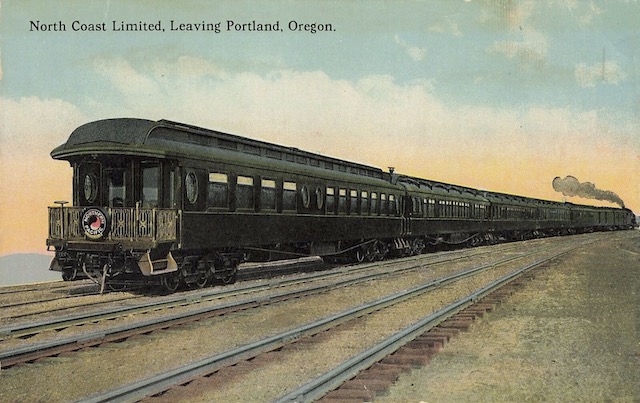
The original North Coast Limited from the rear end. Click image to download a 231-KB PDF of this postcard.
Behind the locomotive, the two trains appear to have different cars but the same general consist. According to the Official Guide, the passenger cars on the train consisted of a second-class coach/smoking car, a first-class day coach, a diner, a Pullman tourist sleeping car, a Pullman Palace sleeping car, and an observation car (which probably also included some berths). Another Pullman Palace sleeper from Seattle would have been added at Tacoma; this car was destined for Yellowstone Park (another sleeper went between Yellowstone and St. Paul). The photos also show two head-end cars, one for baggage and one probably for express.
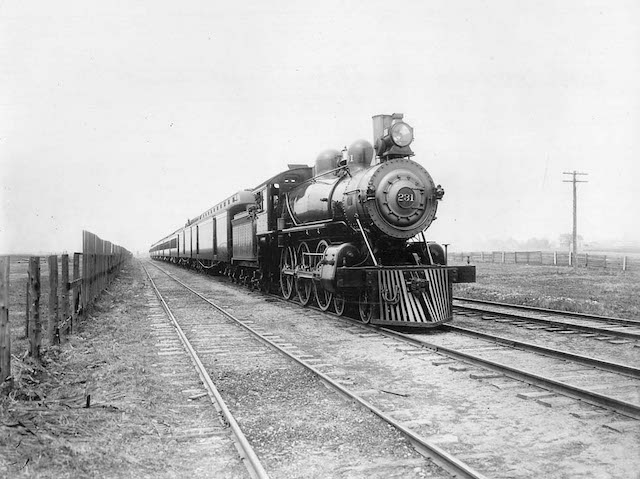
Here, the North Coast Limited appears to be running across the prairie, perhaps in North Dakota or eastern Montana. Click image for a larger view.
Altogether that meant nine cars weighing close to 750 tons going over the Cascade and Rocky Mountains. Such a nine-car train is shown above being pulled by locomotive #231, a 4-6-0 built by Schenectady in 1899 (note again a smaller number assigned to a later locomotive). This engine had taller, 73″ drivers, but otherwise has dimensions that are pretty similar to the 271. Due to the larger driving wheels tractive effort was slightly smaller than the 271 at 24,219 pounds.
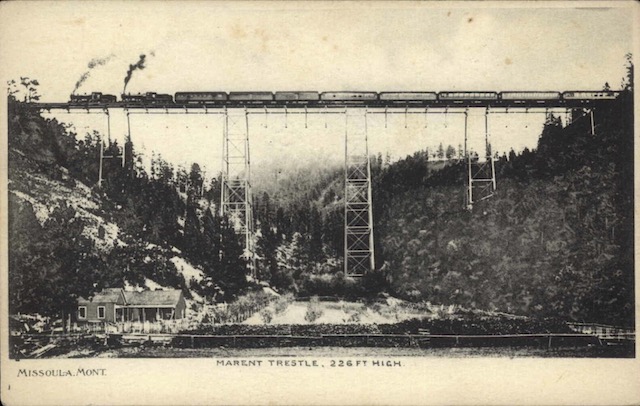
Two 4-6-0 locomotives lead a passenger train across NP’s Marent Trestle west of Missoula, Montana. This card is undated but the photograph was used (with various amounts of colorization) on many postcards dating from 1906 to 1909; since this one doesn’t have a divided back, it must be from 1907 or before. Click image to download a 179-KB PDF of this pre-1907 postcard.
This would have been sufficient on the prairie, where this train appears to be running, but not powerful enough to go over the mountains. As the above postcard shows, NP double-headed passenger trains over the mountains. Though the train in the photo is not the North Coast Limited (too many head-end cars), the railroad’s premiere train would have received the same treatment.
For its first eleven years, the North Coast Limited only trekked as far east as St. Paul. Starting December 17, 1911, the train continued to Chicago via the Chicago & North Western. As I’ve previously noted, NP wanted to reach Chicago to be able to compete with the Chicago, Milwaukee & St. Paul Road (which was building a line to the Pacific), but NP’s half-owned subsidiary Burlington didn’t initially have the capacity to take both the GN Oriental Limited and NP North Coast Limited, which operated on similar schedules, so NP went with the C&NW.
The North Coast Limited was reequipped in 1909 with either wooden or steel-sheathed wooden cars. NP’s 1924 timetables describe its Chicago-Seattle passenger trains as “all-steel.” The 1921 timetable did not make this claim, but I don’t have timetables for 1922 or 1923 to know when the all-steel cars were introduced.
The all-steel North Coast Limited was often 14 cars long, which put a strain on the 4-6-2 Pacific locomotives used to haul the train even though some produced 44,000 pounds of tractive effort. By 1923, rival Great Northern was using 4-8-2 locomotives that produced nearly 55,000 pounds of tractive effort to pull the Oriental Limited. NP, however stuck with its Pacifics a few years longer. As noted here a few weeks ago, in 1926 Northern Pacific developed the 4-8-4 Northern class of locomotive, the first of which produced 57,500 pounds of tractive effort and later models of which were close to 70,000 pounds.
The North Coast Limited was briefly an all-Pullman train. During the 1920s, Northern Pacific’s secondary train on the Chicago-Seattle route was called the Pacific Express westbound and Atlantic Express eastbound. In 1929, NP added a third train, called the Alaskan. At the same time, it made the North Coast Limited an all-Pullman train, including Pullman parlor cars for part of the route but no tourist sleepers or coaches. Due to the Depression, this didn’t last long, and by 1931 the Pacific/Atlantic Express was off the timetable and tourist sleepers and coaches were back on the North Coast Limited.
